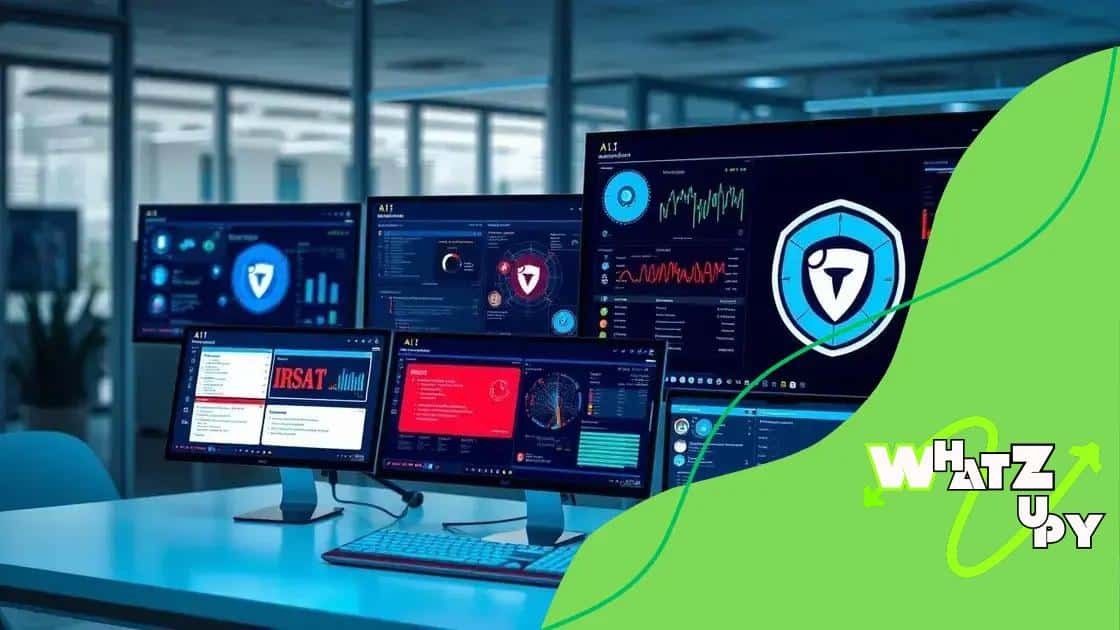The future of AI-powered cybersecurity defense

The future of AI-powered cybersecurity defense focuses on integrating advanced technologies like AI, adopting a zero trust security model, complying with privacy regulations, and enhancing cloud security to effectively combat evolving cyber threats.
The future of AI-powered cybersecurity defense is shaping the way organizations protect their digital assets. As cyber threats become more sophisticated, leveraging AI technology can offer innovative solutions to enhance security. So, how does AI transform the cybersecurity landscape?
Understanding AI in cybersecurity
Understanding AI in cybersecurity is essential as technology continues to evolve. By integrating artificial intelligence into security systems, organizations can vastly improve their defenses against cyber threats. AI helps in analyzing vast amounts of data, identifying patterns, and responding swiftly to attacks.
How AI Works in Cybersecurity
AI systems employ machine learning and algorithms to detect unusual behavior. These systems continuously learn from new data, becoming better at recognizing threats over time. This adaptability is crucial in combating increasingly sophisticated cyber attacks.
Key Benefits of AI in Cybersecurity
- Enhanced threat detection: Quickly identifies potential threats before they escalate.
- Faster response: Automates responses to certain types of security breaches.
- Reduced human error: Minimizes mistakes made by security personnel.
- Proactive security measures: Anticipates and mitigates future risks.
As organizations implement AI solutions, they can process security incidents at a much higher speed. This rapid response capability is vital in a digital landscape filled with constant threats. Moreover, AI’s ability to evolve means that it can stay ahead of cyber criminals.
Integrating AI with existing cybersecurity infrastructures fosters a collaborative approach to security. Human experts can focus on complex problems while AI handles routine tasks, ensuring a more robust defense mechanism overall. Additionally, the use of AI provides real-time insights into potential vulnerabilities, empowering organizations to act proactively.
Challenges in AI Implementation
Despite the advantages, deploying AI in cybersecurity is not without its challenges. Organizations must navigate issues such as data privacy, the need for high-quality data, and potential biases in algorithms. The complexity of maintaining AI systems also requires ongoing investment and expertise.
In summary, understanding AI in cybersecurity reveals both its potential and its challenges. As businesses increasingly rely on technology, leveraging AI tools effectively can become a game changer in fighting cyber threats.
Key benefits of AI-powered defense
AI-powered defense systems bring several significant advantages that transform how organizations approach cybersecurity. As the digital landscape evolves, these benefits enhance security measures and protect valuable data.
Improved Threat Detection
One of the primary benefits of AI-powered defense is improved threat detection. By analyzing vast amounts of data, AI can recognize patterns and anomalies that may signify a cyber threat. This allows for quicker identification of potential attacks, which is crucial for minimizing damage.
Automation of Responses
Another key benefit is the automation of responses to security incidents. AI systems can automatically trigger responses to specific threats, reducing the time it takes to mitigate risks. Automated systems can act faster than human teams, providing timely responses to ongoing attacks.
- Quick containment of threats
- Efficient resource allocation
- Minimized downtime for systems
Additionally, automation frees up human personnel to focus on more complex security challenges, enhancing overall operational efficiency. As AI handles routine tasks, cybersecurity teams can concentrate on strategic planning and threat analysis.
Reduction of Human Error
Human error is a prevalent issue in cybersecurity, often leading to security breaches. AI-powered defense systems significantly reduce the likelihood of mistakes. By relying on precise algorithms and machine learning, these systems help ensure actions taken are based on data, rather than human impulse.
Furthermore, AI continuously learns and improves its responses. This learning mechanism increases its accuracy over time, making it more effective in dealing with emerging threats. With enhanced detection capabilities and a declining risk of error, organizations can achieve better security outcomes.
Proactive Security Measures
AI systems do not just react to threats—they can also anticipate them. By analyzing trends and potential vulnerabilities, AI can help organizations implement proactive measures. This forward-thinking approach is vital in staying ahead of cybercriminals.
Investing in AI-powered cybersecurity can lead to a comprehensive security framework that adapts to ever-changing challenges. Therefore, the key benefits of AI-powered defense extend beyond immediate threat management, establishing a robust foundation for ongoing security improvements.
Common AI cybersecurity tools

Many organizations are turning to AI-powered solutions to enhance their cybersecurity posture. These tools help in identifying, preventing, and responding to cyber threats effectively. Understanding the common AI cybersecurity tools can empower businesses to protect their assets more efficiently.
Intrusion Detection Systems (IDS)
One popular category of AI cybersecurity tools includes intrusion detection systems (IDS). These systems monitor network traffic and analyze it for suspicious activities. By employing machine learning algorithms, IDS can differentiate between normal and abnormal behavior.
Security Information and Event Management (SIEM)
SIEM solutions work by collecting and analyzing security events from various sources. They provide real-time insights into potential threats and vulnerabilities. By combining data from different systems, SIEM can offer a comprehensive view of an organization’s security status.
- Real-time monitoring and alerts
- Data analysis for proactive threat detection
- Incident response automation
These features greatly enhance an organization’s ability to respond to threats quickly and effectively. Additionally, SIEM systems can learn from past incidents, continuously improving their detection capabilities.
Endpoint Detection and Response (EDR)
Another crucial tool is endpoint detection and response (EDR). This technology focuses on endpoint devices, such as laptops and smartphones. By utilizing machine learning, EDR can detect anomalies and threats specifically targeting these devices. It enables organizations to secure their endpoints against sophisticated cyber attacks.
With EDR, companies gain the ability to monitor endpoints in real-time, ensuring that any unusual activity is promptly addressed. This level of monitoring is vital as cybercriminals increasingly target individual devices to infiltrate larger networks.
Threat Intelligence Platforms
Threat intelligence platforms aggregate data from various sources to provide insights into the latest threats. These platforms analyze trends and share vital information about emerging cyber risks. Organizations can leverage this knowledge to enhance their security strategies.
By staying informed about potential threats, businesses can make data-driven decisions to strengthen their defenses. As threats evolve, staying ahead becomes essential, and threat intelligence platforms play a crucial role in this process.
In summary, the use of AI-powered tools such as IDS, SIEM, EDR, and threat intelligence platforms is transforming how organizations approach cybersecurity. These tools not only enhance security measures but also empower businesses to respond proactively to the ever-changing landscape of cyber threats.
Challenges in AI implementations
Implementing AI in cybersecurity comes with its own set of challenges. While the benefits are clear, organizations often face hurdles that can complicate the deployment of AI systems. Understanding these challenges helps in preparing effective strategies for implementation.
Data Privacy Concerns
One significant challenge relates to data privacy. As AI systems require vast amounts of data to function efficiently, organizations must ensure they handle sensitive information appropriately. Balancing the need for data with privacy regulations can be tricky, especially with laws like GDPR.
Quality of Data
The success of an AI system highly depends on the quality of data it receives. If the data is biased or incomplete, the AI’s performance can suffer. Organizations must invest in systems that not only gather data but also validate its quality. Ensuring high-quality inputs is essential for achieving reliable outputs.
- Inaccurate data leads to poor decision-making.
- Biases in data can perpetuate unfair outcomes.
- Continuous monitoring is necessary for maintaining data integrity.
Besides data quality, ongoing maintenance and updates of the AI algorithms are required to adapt to new threats. As cyber threats evolve, AI systems must also learn and adjust. This requires skilled personnel who understand both the technology and the threat landscape.
Skill Gap and Talent Shortage
Another challenge is the skill gap in the workforce. There is a significant demand for cybersecurity professionals who are also AI-savvy. Organizations often struggle to find talent with the expertise needed to implement and manage AI-driven systems effectively. This shortage can delay projects and hinder security efforts.
Training existing staff can be a viable solution, but it requires time and resources. Companies must provide ongoing education and support to ensure their teams can keep pace with advancing AI technologies. Moreover, the fast-paced nature of cyber threats demands that teams are prepared to respond quickly.
Integration with Existing Systems
Integrating AI into existing cybersecurity infrastructures poses additional challenges. Many organizations have legacy systems that are not designed to work with new technologies. This can lead to compatibility issues and make implementation more complex. Proper planning and possibly overhauling outdated systems may be required for successful integration.
In summary, while AI offers powerful tools for enhancing cybersecurity, organizations need to navigate several challenges during implementation. Addressing data privacy concerns, ensuring data quality, closing the skill gap, and integrating new systems are crucial steps in leveraging AI effectively in the fight against cyber threats.
The future landscape of cybersecurity
The future landscape of cybersecurity is rapidly evolving as technology advances. As cyber threats become more sophisticated, organizations must adapt their strategies to stay protected. This means embracing new technologies and approaches to defend against potential attacks.
Integration of AI and Machine Learning
In the coming years, the integration of AI and machine learning will play a critical role in cybersecurity. These technologies can analyze large amounts of data in real time, identifying patterns and anomalies that indicate a security breach. Organizations will increasingly rely on AI to enhance threat detection and automate responses to incidents.
Zero Trust Security Model
The zero trust security model is also likely to gain traction. This approach assumes that threats can originate from both inside and outside the network. According to this model, every user and device must be verified before gaining access to resources. By implementing zero trust principles, organizations can minimize the risk of unauthorized access.
- Continuous monitoring of user activity.
- Strict access controls for all applications.
- Regular security assessments and updates.
This proactive stance is crucial as cyber attackers become more adept at bypassing traditional perimeter defenses. As a result, embracing a zero trust strategy will help organizations protect sensitive data and critical systems.
Increased Focus on Privacy Regulations
Another trend shaping the future of cybersecurity is the growing emphasis on privacy regulations. Laws like GDPR and CCPA are prompting organizations to prioritize data protection. Companies must be transparent about how they collect, store, and use personal data. As these regulations evolve, organizations will need to implement robust compliance measures.
Staying compliant not only avoids legal consequences but also builds trust with customers. Organizations that demonstrate a commitment to privacy will likely gain a competitive advantage in the market.
Cloud Security Innovations
As more businesses move to cloud environments, the need for robust cloud security will increase. Innovations in cloud security will focus on protecting data and applications hosted in the cloud. This includes advanced encryption methods and enhanced access controls to safeguard information from potential breaches.
Furthermore, organizations will need to use secure coding practices and regular security assessments when developing cloud-based applications. By prioritizing cloud security, organizations can ensure their data remains protected, even in a decentralized environment.
In summary, the future landscape of cybersecurity will be shaped by advanced technologies like AI, the adoption of zero trust models, increased focus on privacy regulations, and innovations in cloud security. Organizations that proactively address these elements will be better equipped to combat emerging cyber threats.
FAQ – Frequently Asked Questions about the Future of Cybersecurity
What role does AI play in cybersecurity?
AI helps enhance threat detection and response times by analyzing large amounts of data to identify patterns indicative of cyber threats.
What is the zero trust security model?
The zero trust security model assumes that threats can come from both inside and outside the network, requiring verification for every user and device.
Why is compliance with privacy regulations important?
Compliance helps organizations avoid legal penalties and builds trust with customers by ensuring their data is handled responsibly.
How can organizations improve their cloud security?
Organizations can improve cloud security by implementing advanced encryption methods, regular security assessments, and developing secure coding practices.





